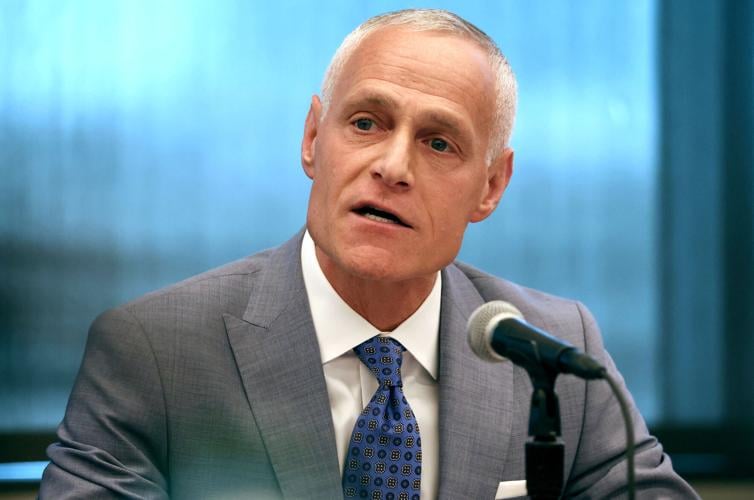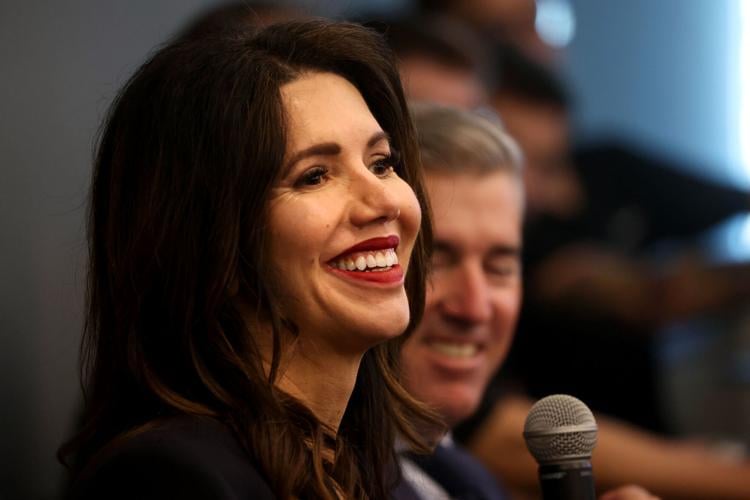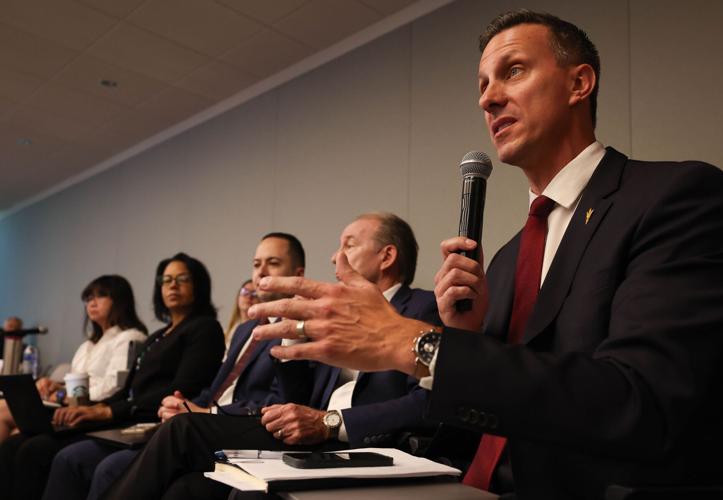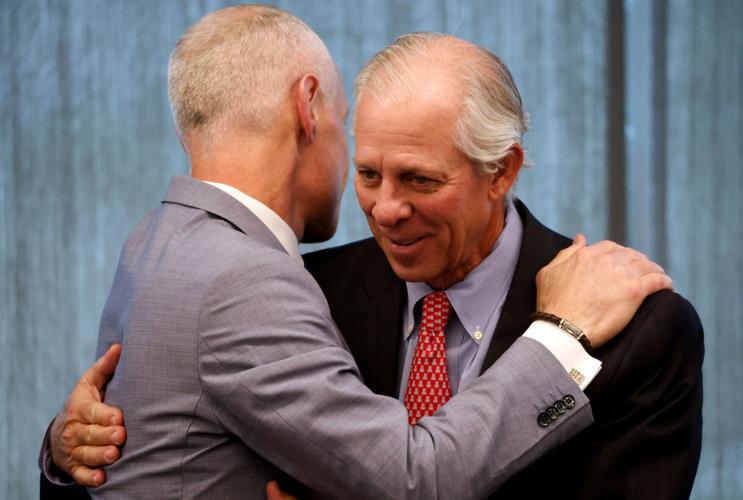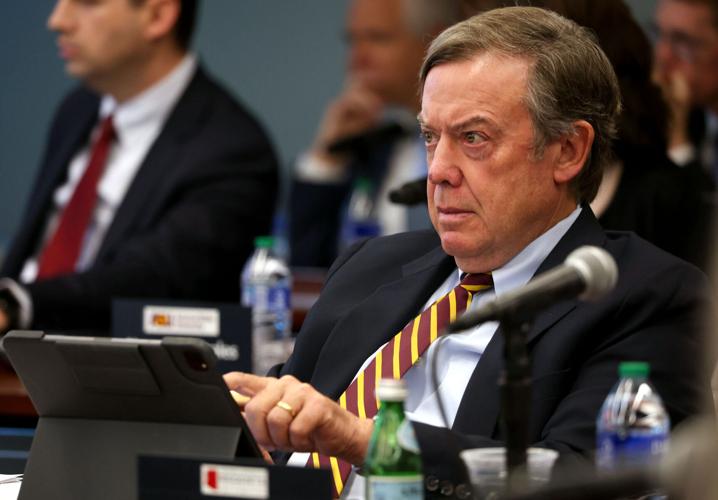TEMPE — Big 12 commissioner Brett Yormark sat before the Arizona Board of Regents on Thursday morning and described a future that’s right around the corner.
Yormark came to the Fulton Center on the campus of Arizona State University to introduce the regents to the conference that ASU, Arizona, Colorado and Utah officially will be joining next month. He also spoke extensively about the seismic changes that are coming to college athletics as soon as 2025.
There’s ample overlap between the two.

Big 12 commissioner Brett Yormark speaks to the Arizona Board of Regents Thursday in Tempe, detailing the conference’s objectives and how it fits into the rapidly evolving world of college athletics.
Throughout his presentation, which included a Q&A and lasted almost 90 minutes, Yormark emphasized that the Big 12 is being run “like a business” under his leadership.
College sports is about to become a business, if it isn’t one already.
The NCAA and its member institutions are in the process of settling three antitrust cases, headlined by House vs. NCAA. The upshot of that settlement: Student-athletes will receive a share of athletic-department revenue moving forward, starting at about $20 million per year.

University of Arizona athletic director Desireé Reed-Francois speaks during an Arizona Board of Regents meeting Thursday in Tempe.
“It’s fair to say that collegiate athletics is moving closer to where I came from than where we are today,” said Yormark, who held several positions in professional sports before becoming Big 12 commissioner in August 2022. “And I’m very prepared for it.”
One of the slides that Yormark showed detailed the Big 12’s “priorities for fiscal year ’25.” They included maximizing brand relevance, creating value, driving revenue and managing expenses.
Another slide showed the conference’s staff organizational chart. It included nearly 50 positions.
“The industry that we’re in today needs a reset. And we’re going to go through one,” Yormark said. “It will be challenging. We’ll have to think about life differently. But I think, ultimately, we’re going to land in the right place for all of us.”
UA athletic director Desireé Reed-Francois and ASU counterpart Graham Rossini also spoke at the meeting. Attendees included their bosses, Robert C. Robbins and Michael Crow.

Arizona State University President Michael Crow listens to Big 12 Commissioner Brett Yormark’s in-person remarks to the Arizona Board of Regents Thursday in Tempe.
In an interview with the Star after Yormark’s remarks, Reed-Francois took his notion of an industry-wide “reset” even further. She called it an “evolution.”
“I’ve been in higher education and college athletics for about 25 years,” Reed-Francois said. “What we’re seeing is one of the largest transformations in our history and it’s at a very accelerated pace. It’s a good change.
“But ... change can be uneasy. Change can be nerve-racking. We all crave consistency.
“As we look at this new world we’re going into, we know there’s going to be bumps. We know there’s going to be challenges. But that’s OK.
“We’re going to embrace them. We’re going to see them as opportunities. We’re going to take them on head-first.”
Pros and cons
Amid all the talk about revenue, Yormark made sure to emphasize that the “well-being of student-athletes” remains at the forefront of the Big 12’s mission. But at least one of the regents pushed back at the idea of professionalizing college athletics.

Manson
“As a former student-athlete, this grates on me a little bit,” said ABOR treasurer Lyndel Manson, who ran cross-country at Middlebury (Vermont) College. “We’re dealing with 18- to 20-year-old kids who have no real idea what their future holds, how to manage the things that are coming at them.
“It’s always been very important to me that the ‘student’ part of the ‘student-athlete’ come first. So I’m struggling with how (to) react positively to this.”
Additionally, Manson questioned whether student-athletes should receive scholarships if they’re also getting a portion of athletic-department revenue, saying it “feels a bit like double-dipping.” Widening inequities between conferences (Big Ten/SEC vs. everyone else) and sports (revenue vs. nonrevenue) sparked concern for Manson as well.
“I just don’t understand how we get through those knotholes,” she said.
“I can tell you we’re discussing all of that,” Yormark responded. “We’re not there right now. It’s a whole new age for student-athletes. How do they adjust? How do we not take advantage of them?

Big 12 commissioner Brett Yormark, left, embraces University of Arizona President Robert Robbins in Tempe following a meeting Thursday of the Arizona Board of Regents.
“How do you work with them on orientation programs? Financial literacy? I think it’s incumbent on all of us to take an active role in that.
“When you talk about ‘double-dipping,’ I think a lot of people feel that way. We’re going to have to make some adjustments.”
Everything is on the table between now and the fall of 2025 — including the athletes’ training table. Yormark said some athletic directors have told him that they plan to reduce the amount of food available to student-athletes once revenue-sharing kicks in.
“We’ve got a decent amount of time to vet all these issues and to get prepared,” he said. “But we’re on the clock now.”
‘The 50’
Toward the end of the meeting, the regents asked Reed-Francois and Rossini to join Yormark on the dais. Soon after, Manson raised another issue.
“My concern is that we’re developing a system that is so focused on the few,” she said, referring to the small percentage of college athletes who go on to become pro athletes. “We need to make sure it serves the many.”

Arizona State University athletic director Graham Rossini speaks during an Arizona Board of Regents meeting Thursday in Tempe.
Reed-Francois said she has met with hundreds of recruits and their families during her time at Arizona, Missouri, UNLV and elsewhere. She always talks to them about “the 50.”
“How are you going to impact the world for 50 years?” she said. “How are our student-athletes going to impact the world when they graduate?”
Reed-Francois used some basic math to illustrate her point. The average NFL career lasts 3.3 years. The average life expectancy in the U.S. is 76.33. So if a would-be pro football player graduated at 22 and had an average NFL career, he’d have another 50 years to make an impact on society.
“The ‘student’ part of the ‘student-athlete’ is what we’re all committed to in this industry,” Rossini said. “How that gets defined (is) to be determined in the coming months. But I know speaking for ASU and ... the University of Arizona, we will not compromise from our focus. This is still higher education. They’re still student-athletes.
“They have new abilities and opportunities that are afforded to them. That’s a wonderful outcome. So embracing that but not losing focus on the point of what we’re here to accomplish in developing young people.”
Yormark, Reed-Francois and Rossini acknowledged that much remains unknown about the future of college athletics — even as the court settlement draws close. Issues that are still unresolved include the role of Title IX and roster limits in each sport.
Reed-Francois said the UA won’t compromise its commitment to winning, no matter how the industry shifts.
“We are a championship-level program,” she told the Star. “For us to continue to compete at this level, we have got to participate fully in revenue share. It’s going to benefit our student-athletes. Our programs have to do this for us to continue to compete at this level.
“The how — that’s something we’re working on.”
Pac-12 Hotline: The last sentence of the final slide of Big 12 commissioner Brett Yormark's presentation Thursday in Tempe to the Arizona Board of Regents resonated loudly in imploring the regents, and U of A and ASU, to continue to invest in college athletics.


